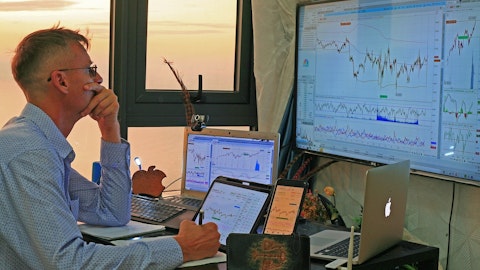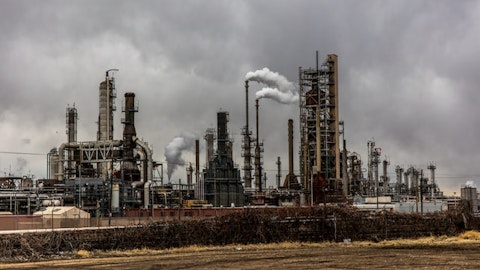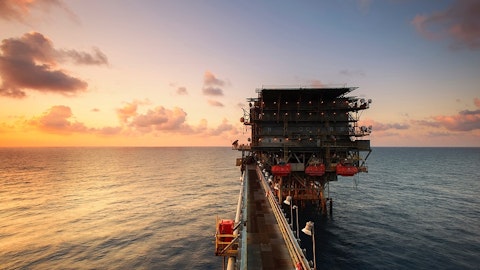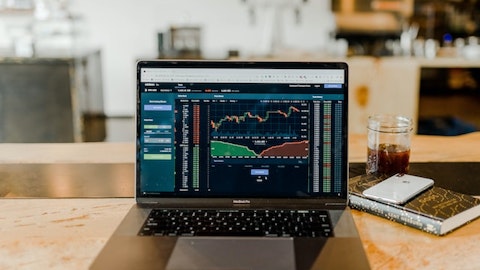Marathon Oil Corporation (NYSE:MRO) Q2 2023 Earnings Call Transcript August 3, 2023
Operator: Good morning, and welcome to the Marathon Oil Second Quarter 2023 Earnings Conference Call. [Operator Instructions]. I would now like to turn the conference over to Guy Baber, Vice President of Investor Relations. Please go ahead.
Guy Baber: Thank you, Danielle, and thank you as well to everyone for joining us on the call this morning. Yesterday, after the close, we issued a press release, a slide presentation and investor packet that address our second quarter 2023 results. Those documents can be found on our website at marathonoil.com. Joining me on today’s call are Lee Tillman, our Chairman, President and CEO; Dane Whitehead, Executive VP and CFO; Pat Wagner, Executive VP of Corporate Development and Strategy; and Mike Henderson, Executive VP of Operations. As a reminder, today’s call will contain forward-looking statements subject to risks and uncertainties that could cause actual results to differ materially from those expressed or implied by such statements.
I’ll refer everyone to the cautionary language included in the press release and presentation materials as well as the risk factors described in our SEC filings. We’ll also reference certain non-GAAP terms in today’s discussion, which have been reconciled and defined in our earnings materials. So with that, I’ll turn the call over to Lee and the rest of the team who will provide prepared remarks today. After the completion of these remarks, we’ll move to a question-and-answer session. Lee?

Lee Tillman: Thank you, Guy, and good morning to everyone listening to our call today. First, I want to again kick off our call by expressing my thanks to our employees and contractors for another quarter of comprehensive execution against our framework for success. We don’t take such delivery for granted, and I’m especially grateful for your commitment to safety and environmental excellence in addition to delivering on all of our operational and financial objectives. Well done on another great quarter, while staying true to our core values. There are a few takeaways I want to leave you all with this morning. First, we delivered another very strong quarter on all fronts, highlighted by sequential increases to our cash flow from operations, free cash flow and our total company oil and oil-equivalent production.
We delivered around $530 million of free cash flow during the second quarter, with a significant increase from first quarter driven by strong execution and improving production trend and a catch-up in EG cash distributions. Second key takeaway. We continue to lead our peer group and the broader S&P 500 in returning capital to our shareholders. During second quarter, we returned $434 million to shareholders, including $372 million of share repurchases. Through the first half of 2023, we’ve returned over $830 million to our shareholders, representing 40% of our top line cash flow from operations consistent with our framework. Our differentiated cash flow-driven return of capital framework continues to prioritize our shareholders as the first call on our cash flow, not the drill bit and non inflation.
First half 2023 return of capital represents a double-digit total shareholder distribution yield on an annualized basis and the highest in our E&P peer space. Our commitment and consistency and returning significant capital is contributing to peer-leading growth in our per share metrics. We’ve now reduced our outstanding share count by 24% in just the last 7 quarters, and we are on track to deliver 30% year-over-year production growth per share. Our third and final key takeaways this morning. Our forward outlook remains compelling and differentiated. We are on track to deliver a 2023 business plan that benchmarks at the top of our high-quality E&P peer group on the metrics that matter most: shareholder distributions, free cash flow generation, reinvestment rate, capital efficiency, free cash flow breakeven and production growth per share.
Our business plan remains on track with operational and financial momentum improving over the second half of the year. More specifically, our first half weighted capital spending and completion activity will drive our third quarter total company oil and oil equivalent production to at or above the high end of our annual guidance range. With both higher production and lower CapEx over the second half of 2023, we expect continued sequential improvement to our underlying free cash flow generation across the third and fourth quarters. And finally, to our annual production guidance ranges remain unchanged, our full year oil equivalent production is trending above the midpoint of that guidance. Looking ahead to 2024. While it’s too early to share any specific guidance, rest assured that our framework for success and core priorities will remain unchanged.
Our case debate will be another year of maintenance level oil production that maximizes our sustainable free cash flow and prioritizes shareholder distributions and per share growth. My expectation is that we will once again lead the peer group on the metrics that matter most in 2024, benefiting from any deflation that might present itself in the market, as well as from the added tailwind of a significant financial uplift in EG from our increased exposure to the global LNG market. With that, I’ll turn it over to Dane, who will provide a brief financial update.
Dane Whitehead: Thank you, Lee, and good morning, everyone. As we mentioned, second quarter was a tremendous financial quarter for us as we generated $531 million of adjusted free cash flow and returned $434 million of capital back to shareholders. That’s a 10% increase in shareholder distributions relative to the first quarter. Importantly, we expect our financial delivery to improve even further over the second half of the year. On a price normalized basis, we expect our free cash flow generation to improve across the third and fourth quarters relative to the second quarter’s already meaningful level, driven by higher expected production and lower capital spending consistent with the phasing of our 2023 program. Returning significant capital back to our shareholders remains foundational to our value proposition in the marketplace.
We’re focused on building a long-term track record of consistent shareholder returns through the cycle that can be measured in years, not just quarters, and the first half of 2023 represents another successful step in that journey. Through the first 2 quarters of the year, we returned over $830 million to shareholders, representing 40% of our adjusted CFO. First half return of capital translates to a double-digit shareholder distribution yield on an annualized basis, and that’s the highest in our peer group. Over the trailing 7 quarters, we’ve now returned approximately $4.6 billion back to shareholders. That’s almost 30% of our current market capitalization that we’ve returned in less than 2 years. We repurchased $4.2 billion of our stock at attractive levels, driving a 24% reduction in our outstanding share count, contributing to pure leading growth in our per share metrics.
We remain confident. Our cash flow-driven return of capital framework is uniquely advantaged versus peers, providing investors with first call on cash flow and offering them a differentiated shareholder return profile. Our framework is sector-leading and transparent, providing clear visibility to one of the strongest shareholder distribution yields in the entire S&P 500. For the full year, we expect to continue to deliver against our framework, returning a minimum of 40% of our top line CFO to shareholders. We’re committed to the powerful combination of a competitive and sustainable base dividend and material share repurchases. More or less our base dividend unchanged this quarter. Keep in mind that we’ve raised it basically last 11 quarters, and we’re well positioned for another dividend raise later this year, with the increase expected to be fully funded by the share count reduction from our buyback program.
This is consistent with our focus on sustainability and our objective to maintain one of the lowest post-dividend free cash flow breakevens in the peer space. Additionally, we have ample capacity to continue buying back a significant amount of our stock with $1.8 billion of share repurchase authorization outstanding. Our plan is to maintain our return of capital leadership and improve our already investment-grade balance sheet through gross debt reduction. We can do both, and that’s exactly what we’re demonstrating. We paid down $200 million of high-coupon U.S. debt so far this year and remarketed $200 million of tax in bonds at a favorable interest rate. The strength and durability of our shareholder return and balance sheet enhancement initiatives are underpinned by the quality of our assets, our disciplined capital allocation framework, our peer-leading capital efficiency and our strong free cash flow generation.
This is proven out by our leadership position when it comes to the most important metrics for our sector. For full year 2023, we expect to deliver the best free cash flow yield in the high-quality E&P space, the lowest reinvestment rate and among the best capital efficiency, all while maintaining the lowest enterprise free cash flow breakeven on a pre- and post-dividend basis. With that summary, I’ll turn it over to Mike to provide a brief update of our 2023 execution that’s delivering the sector-leading outcomes.
See also 10 Best Oil Refinery Stocks to Buy and 15 Biggest Oil Refining Companies in the World.
Michael Henderson: Thanks, Dane. My key message today is that the priorities for our capital program remain unchanged and that we remain fully on track to deliver on our key commitments to the market, including our annual capital spending and production guidance. Starting with our capital program, we spent just over 60% of our full year budget during the first half of the year, fully consistent with our stated business plan. We expect third quarter capital spending to be in the $400 million to $450 million range, with a further moderation expected in the fourth quarter and are well positioned to take advantage of any deflationary tailwind in the second half of the year. For the full year 2023, the midpoint of our annual capital guidance remains a reasonable assumption for your models.
In terms of the service cost environment, first half 2023 pricing was very consistent with our expectations entering the year. We started to see a general plateauing of cost during the second quarter and had improved access to services and equipment. The macro environment remains dynamic. We’ve now started to see an improved pricing trend across raw materials and most service lines in equip, consistent with a lower level of industry-wide drilling and completion activity. We’ll look to capture better pricing where we can with the balance of the year, while continuing to protect our execution excellence, where we are also seeing a number of positive trends. To that point, year-to-date, field-level execution has been very strong and efficiency outperformance has us tracking to the higher end of our annual wealth sales guidance in the Eagle Ford, Bakken and Permian.
While this won’t have a material impact on our full year 2023 capital for production, it should enhance our production momentum into 2024, where we also believe there will be more opportunity to capture deflation in the market. Turning to production. The phasing of our capital program is driving strong production momentum into a strengthening commodity price environment. For third quarter specifically, we expect total company oil and oil equivalent production to be at or above the high end of our annual guidance range before a modest sequential decline into the fourth quarter. For full year 2023, we’ve reiterated our production guidance ranges of forward trending above the midpoint of guidance on an oil equivalent basis. The combination of higher production and lower capital spending over the second half of the year is expected to drive even further improvement to our underlying free cash flow profile.
Turning briefly to our integrated gas business in EG after receiving a substantial catch-up cast distribution. During second quarter we expect the relationship between earnings and cash distributions to normalize over the second half of the year. Third quarter distributions should be somewhat evenly split between dividends and return of capital. Looking a bit further ahead to 2024, we continue to expect to realize significant financial uplift in EG on the back of an increase in our global LNG price exposure. We’re right on track with all the necessary contractual milestones. And beginning January 1, 2024, all the sourced LNG will no longer be sold at Henry Hub linkage. It will be sold in the global LNG market. This arbitrage between Henry Hub and global LNG pricing trickled with the highly competitive market for LNG cargoes from reliable suppliers is expected to drive significant financial uplift for our company at current forward card pricing.
To take further advantage of these new commercial terms, we are actively assessing up to a 2-well infill drilling program at Alba, targeting high confidence, low execution risk, shorter cycle opportunities that should mitigate base decline and maximize equity molecules through the LNG plan under the more attractive global LNG linked pricing. These opportunities are expected to compete with the risk-based returns generated from our U.S. resource plays, although any Alba infill capital spending is unlikely to make a significant impact on our overall 2024 capital program. Yet, it’s not just about capturing near-term commercial uplift in EG. As we’ve stated before and consistent with the recently executed HOA with the EG government and our partner Chevron, we’re equally focused on the longer-term outlook via the gas mega hub concept.
By truly leveraging our unique world-class infrastructure in one of the most gas prone areas of West Africa, we expect to extend the life of EG LNG well into the next decade and further enhance our multiyear free cash flow capacity. The next phases of development in the same gas [indiscernible] as well as potential cross-border opportunities. With that, I will turn it over to Lee, who will wrap up our prepared remarks.
Lee Tillman: Thank you, Mike. For years now, I have reiterated that for our company and for our sector to attract increased investor sponsorship, we must deliver financial performance competitive with other investment alternatives in the market. As measured by corporate returns, free cash flow generation and return of capital, more S&P, less E&P. We’ve delivered exactly that type of performance over the last 2 years and not just competitive, but at the very top. Our one-line investment thesis is this: top-tier sustainable free cash flow generation with an advantaged return of capital profile and sector-leading per share growth, all underpinned by an investment-grade balance sheet. For 2023, we’re well positioned to again lead both our peer group and the S&P 500 on the metrics that matter most.
If this pure-leading financial and operational delivery is not a 1-year phenomenon. It’s a continuation of a multiyear trend and sustainable. And looking ahead to 2024, I don’t expect anything to change. My confidence is underpinned by our high-quality and oil-weighted U.S. unconventional portfolio that’s complemented by our unique fully integrated global LNG business in EG. To close, I want to reiterate how proud I am of the way we position our company. We are results driven, but it is also about how we deliver those results. staying true to our core values and responsibly delivering the oil and gas the world needs. And the world needs more energy, not less. The energy transition is really an energy expansion and oil and gas is uniquely positioned to drive global economic of living we have all content to enjoy.
With that, we can open the line up for Q&A.
Q&A Session
Follow Marathon Oil Corp (NYSE:MRO)
Follow Marathon Oil Corp (NYSE:MRO)
Operator: [Operator Instructions]. The first question comes from Arun Jayaram of JPMorgan.
Arun Jayaram: Lee, Dan and Mike, you mentioned how your free cash flow should inflect in the second half of this year, just given the, call it, $450 million decline in higher output in oil prices. So I wanted to get your thoughts on how you balance cash return in the second half between equity holders, debt reduction and perhaps building up the cash balance. You’ve been operating around $200 million in cash for this year. So just thoughts on balancing those 3 items.
Dane Whitehead: Yes. Sure, Arun. Yes, the cash return conversation is so central to the value proposition for shareholders. I might take a little longer than you anticipated to cover this, but just to be thorough, we’ve really been steady executing a return of capital framework and it calls for a minimum 40% of operating cash flow in the form of either share repurchases or a base dividend. And obviously, our track record on meeting that minimum return, it’s very solid and unwavering, and we expect that to continue that going forward. We returned exactly 40% in the first half 2023 CFO to shareholders. That’s $700 million in share repurchases plus $125 million base dividend, which equated to 11% [indiscernible] distribution yield is really at the top of the class in terms of return.
Now on top of that, we also paid off $200 million of 8-plus percent coupon U.S. tax debt and kind of balancing those share repurchases and returns to investors with debt reduction is something that will be a feature for us going forward. We certainly continue to see share repurchases as the preferred return vehicle for the lion’s share of our shareholder returns. Our stock is trading at a free cash flow yield in the mid-teens. So for purchases continue to be very value accretive, a real efficient way to drive per share growth, and they’re synergistic with growing our base dividend, as I referenced in my prepared comments. We have $1.8 billion of repurchase authorization outstanding. So plenty of running room there. And the per share growth that we’re driving 24% since fourth quarter of 2021 when we restarted this program, it’s pretty eye-watering.
So for the balance of the year, we expect us to continue to return 40% of operating cash flow and look to pay down additional debt. Now make no mistake, the 40% return to shareholders is the top priority. The second priority will be to continue to start to pay down the term loan that we took out when we acquired the Ensign Eagle Ford asset. We have a very significant cash flow inflection that we started to free cash flow inflection that we started to realize in the second quarter, but we expect that to continue in the third and the fourth quarter. And even on a price normalized basis, we’re going to have a lot more flexibility than we’ve had over the past couple of quarters to serve both of those needs, shareholder return and debt reduction.
With the tailwind we’re seeing in commodity prices, particularly WTI right now, that’s going to provide even more flexibility. We can go bigger on share repurchases, and we can go faster on debt reduction or some more likely some combination of those. You asked about cash balance. We’re operating around $200 million right now. And in the course of the month, we actually made a negative. It need to borrow on our credit facility a little bit, waiting for the big 20th of the month check for oil receipts, which is — that’s the big time when a big way for cash flow comes into the company. that working capital that we’re managing the mechanics of that. We actually just established a commercial paper program, which is very cost effective compared to the credit facility.
And so I think we’re comfortable with that. Over time, we may build up cash, but I don’t — it’s not a priority for us right now. Right now, it’s going to be hit to 40%, exceed it where we can and take down that term loan to get that interest expense out of the system.
Arun Jayaram: That’s helpful. My follow-up maybe is for Mike, is kind of maybe a 2-parter. Mike, your updated TIL guidance is about 17 TIL is higher, 230 versus 213. Does that impacting any production from from the higher TILs, that was a question from the buy side. And then maybe I’d love to see if you could describe the positive variance in the Eagle Ford this quarter and maybe a little bit light in the Northern Delaware, a couple of those variances in 2Q.





